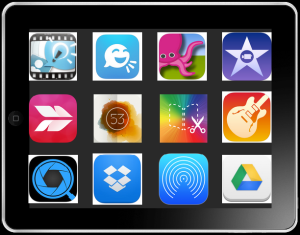When a colleague suggested that I attend the ISTE Conference for K-12 educators, I was a bit skeptical. I thought, “What can I learn from K-12 educators that would be applicable to the undergraduates – and often graduate students and faculty members – I work with as a librarian?” However, as I browsed through the workshop and session descriptions, I realized that we in higher education can take a few pages from the books of K-12 educators to enhance teaching and learning at the college level. Here are some highlights I took away from the conference:
-

Image by Greg Kulowiec, retrieved from http://tinyurl.com/pcrxrqy 1. iPad Apps. There are so many. Whenever someone asks me for app recommendations, I often turn to my “go-to’s” without doing much more hunting. In a workshop about using tablets in the classroom, I learned so much about app integration for both content (student learning) and creation (student making). For example, AppFusion or App Smashing is the process of using several apps to create different parts of a project, and then using one app to pull all the parts together. One such “fusion” app is ThinkLink, which can incorporate sound, video, images and text to create a short presentation, much like a PowerPoint or Prezi. Learning about all of these different apps stressed our responsibility in higher education to be knowledgeable about a variety of apps for different functions, such as video creation, white board drawing, or photo editing. A grid with apps, their functions, preferred platforms, etc. is a simple tool that we can develop to help students and faculty choose the right apps to use in the classroom, especially as we prepare new iPads for our lending program this fall.
-

Image retrieved from https://conversationprism.com/ “Deeper learning.” Learning in the classroom is great, but if it can’t be applied to real-life situations, it may not stick for all students. Presenters Chris Dede of Harvard and Julie Evans of Project Tomorrow explained that “deeper learning” involves this connection between learning and life, and also spoke about essential strategies for mobile learning, stemming from their 2014 Qualcomm report, The 8 Essentials for Mobile Learning Success in Education. One of the highlights included a video of an augmented reality project where students interacted with hotspots on their mobile devices when out studying a pond in order to reinforce ecological concepts. The presenters also stressed the importance of how students use social media platforms to think together and share information, and offered a great resource called the Conversation Prism. One point that stuck with me in terms of working with students and faculty at Penn involved developing fluency in interactive media. Chris Dede made the point that often, we have to create communities of “unlearning” the more traditional methods we’re used to, in order to become fluent in various media and collaborative, inquiry-based learning strategies. This is a tall measure for folks in higher-ed, but nevertheless something I believe we should all be striving toward.
- Backchannels. A backchannel is a second form of communication that takes place at the same time as a face-to-face session, whether it’s a lecture, conference session, or other learning activity. In a great session on backchannels, where we modeled this behavior during the presentation, a high school teacher and college professor explained how they use backchannels, why they’re useful in the classroom, and shared a variety of different channels to consider. In one class, students used a backchannel while watching a video in order to answer certain questions about content and also ask questions of the teacher and other students. Backchannels, which include popular options like Twitter (using a class hashtag, for example), Today’s Meet, and Backchannelchat.com, can be a great way of getting students who usually don’t participate to join the conversation. In a “fishbowl” scenario, students on the outer edge of the class can be using the backchannel, while those on the inner circle can be paying attention real-time, and then roles reverse halfway through class. On certain platforms, students can remain anonymous to each other on a backchannel, but the instructor knows who’s chatting and can do some formative assessment. Some other backchannel platforms include Piazza, Tozzl, and Socrative. We often get questions from faculty about backchannels here at WIC, and this presentation made me feel more prepared to recommend different tools and discuss the pros and cons of using backchannels in teaching and learning.
Other great resources I learned about at ISTE included those about digital and media literacy, such as Common Sense Media’s digital citizenship curriculum, and how to teach and implement digital literacy using strategies from the Center for Media Literacy. I learned so much from K-12 educators at the ISTE conference. I now have some new goals and much personal learning to do as we prepare for the fall semester!
Great post with excellent ideas and examples! Thanks!
LikeLiked by 1 person
Thanks, Catrice – glad you found it useful!
LikeLike